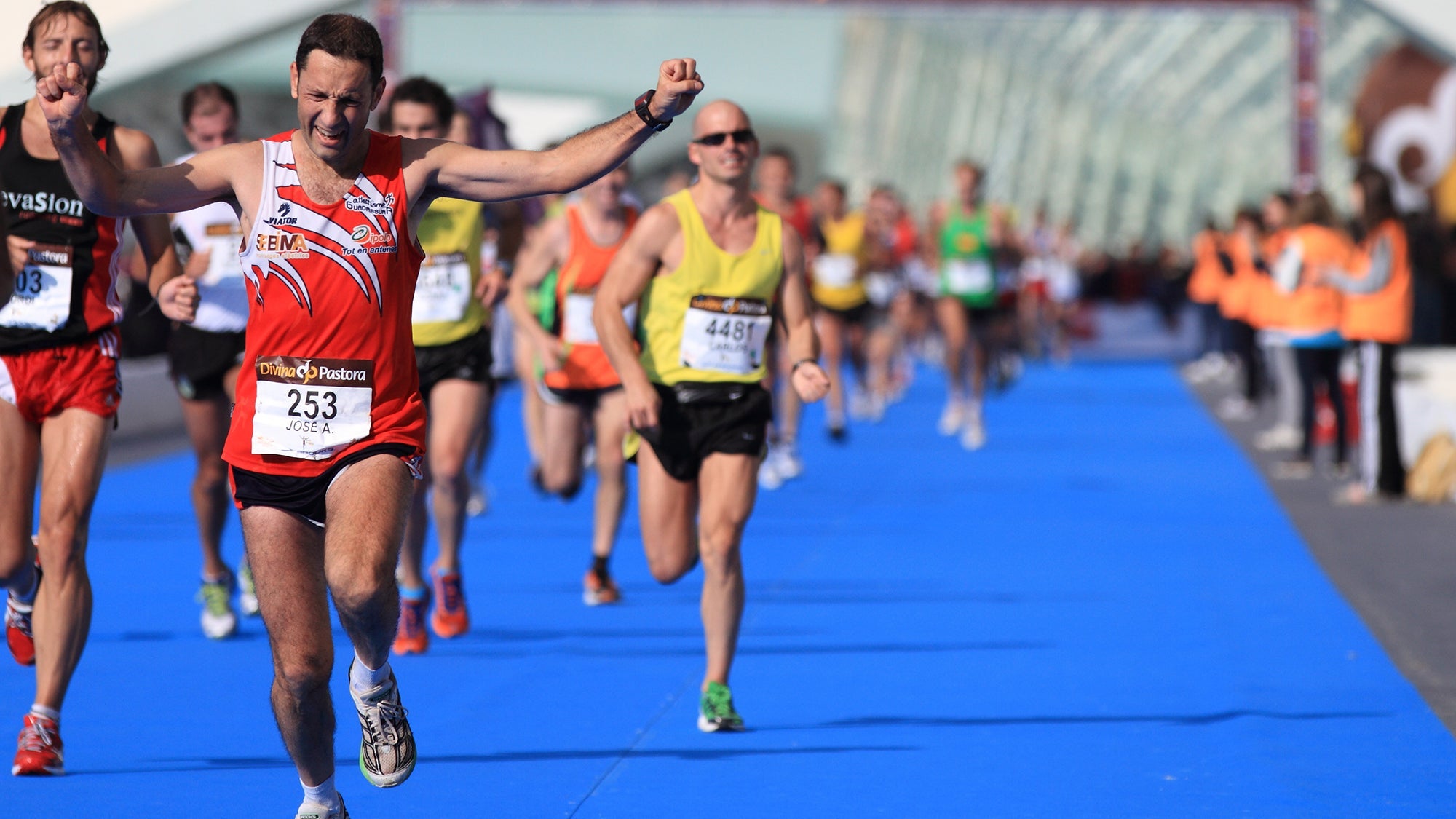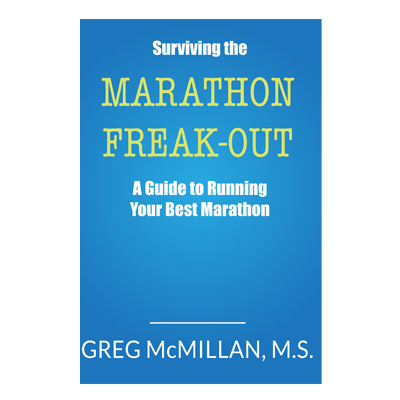I’ve been able to dial in how to truly peak on marathon day. It took a while to figure it out, because, like many coaches, I fell into the standard “tapering” model we’ve all been taught. Problem was, tapering didn’t work consistently. The results were just as hit-or-miss as not tapering at all.
So, I threw “tapering” out of my vocabulary. I replaced it with “peaking.” Semantics? Maybe. But by studying peak performance—both physiological as well as psychological—as opposed to just the tapering research, I’ve been able to consistently get runners optimally ready on marathon day. It works for all athletes no matter where you find yourself in the pack come race day.
Here are my guidelines for your peaking phase—the last 14 days before your marathon—and these ideas form the basis of my peaking training plans in my e-book, Surviving the Marathon Freak-Out, as well as my guidance for what you should do before, during and after the marathon:

#1: Don’t change your weekly running routine
Our bodies and minds like routine. If you run three days per week, then run three days per week during your peaking phase. If you run five, then run five. Your legs will feel heavy and “flat” if you suddenly run less frequently than normal. Here’s a quick story to prove the point:
A few years ago, I coached a new runner program in San Diego. A masters female runner (who ran 4 days per week) was prepped and ready for a great marathon. On race day, however, she ran horribly and was nowhere close to her goal time. When we met up a few days after the race, I asked her what went wrong.
“I don’t know Greg. The training was great and I feel your workouts really prepared me for the race,” she said shrugging her shoulders. After a little more investigation, I found the problem. I asked her about race week, a time when things can go wrong if you aren’t careful. “Race week was great. Because I wanted to really rest up for the marathon, I took Wednesday, Thursday, Friday and Saturday off. I wanted to save all my energy for the marathon on Sunday,” she revealed. Bingo!
Her body was used to running four times per week and suddenly she rested for four straight days. Every runner knows how awful you feel if you miss a few days of running. You feel like you’ve never run before in your life! And, that’s exactly how she felt. She was completely flat on race day. She learned this rule the hard way and it was a great reminder for me (and now you): Stick to your running rhythm during the peaking phase.
That said, there is one exception to this rule: Runners who feel they are on the edge of overtraining or are nursing a sore muscle or niggling injury may take an extra day off each week during the peaking phase. But, don’t take it the day before the last long run or the race if you don’t normally rest the day before your long runs. This risks feeling flat on race morning.
#2: Reduce weekly training volume, but not too much
Over the last 10-14 days before your race, you should progressively reduce the volume of your running. Two weeks out from the race, I like to reduce the daily volume by 10–20 minutes or so.
For most runners, that’s no big deal. But, what if you only run 30 minutes per day normally? Still follow the plan. Reduce your run to 10–20 minutes (30 minutes minus 10–20 minutes). It will feel like you spent more time getting ready for the run than going for the run, but your body will benefit even from very short runs.
The week of the race, reduce your normal daily volume approximately 20–30 minutes. (Again, this may mean low mileage runners may only run 10–20 minutes but that’s okay.) This, along with the normal reduction in your long run length as the race nears, will drop your overall running volume in line with what we know from research (and, more importantly, from practical experience). This allows the body to get prepared for a peak performance (~20–40% total reduction in training volume depending on the athlete).
The extent of your volume reduction during the peaking phase depends on your normal training volume and how tired you feel from the training. Lower mileage and rested athletes will reduce volume less than high mileage runners who are fatigued from training.
That said, don’t make the common mistake of dropping your volume too much. This takes your body out of its routine and can leave you stale on race day. My opinion is that more runners fail because of tapering too much (see #1 above) rather than not enough.

#3: Keep the engine revved
While we want to reduce the volume of running, we do not want to reduce the intensity of our workouts. In fact, we may want the intensity to increase. You want to keep your engine revved, the pumps primed. Never race your workouts, but during the peaking phase, don’t back off from all faster running either. I’ve found that some fast running in the peaking phase helps bring the body and the mind to tiptop condition on race day. (See my Peaking Plans in the e-book for the workouts I recommend.)
While these workouts aren’t “push it to the max” workouts, they should help build your running economy (think of it as better gas mileage) and dial in your goal pace. Done correctly, the peaking workouts stress the body less but leave you with an engine that is primed and ready to deliver on race day. These peaking workouts aren’t as extensive or high volume as you might do earlier in the marathon training, but they do provide just enough stimulus to really help you peak on race day.
#4: Plan your strategy and stick with it
Most marathoners have the same race strategy—start conservative, build into race pace, run as efficiently as possible and get as deep in the race as possible before you have to pull out your super powers to get you to the finish line. Yours may vary, depending on your strength and preferences and race course, but no matter what your strategy, stick with it.
For most runners, their pre-race strategy is the best strategy. Be open to change if the conditions require, but for the most part, you know what you need to do so just get out of your own way and let the race unfold as planned.
Of course, the biggest error is feeling great in the first few miles (which should feel easy any way) and deciding, “I think I’ll put some time in the bank in case I slow down later.” Big no no. Your faster pace may feel easy but you are burning essential stored carbohydrates and stressing your muscle tissues too much, too soon. Later in the race, you’ll pay for it and can easily lose several minutes per mile compared to the few seconds per mile you “banked” early in the race.
(Later in the book, I provide my pace chart for running your best even or negative split race.)

#5: Reflect on training to build confidence
I like athletes to reflect on training in two ways. First, think back on a particularly tough workout, one where you didn’t feel great but you gutted it out. You were tough. This shows that you can do it. You are tough. You can handle the ups and downs of running and get to the finish line. You have loads of determination. This will be required in your marathon, so instead of thinking of that run as a “bad” workout, see it as revealing your inner strength.
Next, think back to your best workouts or races. Really re-live them in your mind. Bolster your confidence knowing that you are fit, fast and ready. Bring on the race! Get excited to go out there and perform like you know you can! Your training successes should build your confidence and confidence is a key part of the peaking process.
In fact, your homework is to review your training plan and highlight 2-3 runs/workouts/races where you felt great, really awesome. Put pen to paper (or fingers to keyboard) and write down everything you remember about the day. Come at it from all your senses and really “feel” the run. Then, start to read about these great runs every few days as the race nears. You’ll be surprised how this ongoing positive mental stimulus can carry over into the race.

#6: Have fun and smile
Let’s face it. Most of us aren’t going for an Olympic gold medal here. We are simply enjoying the challenge of doing our best. There is no real pressure, so quit putting so much on yourself. We run for fun, and you should remember that. Have fun! I encourage runners to smile a lot in the final days before a race. Smiling puts you in a better mood, reduces anxiety and that can play a big role on race day.
It’s only with a positive, happy mindset focused on doing your best, combined with a well-trained body that is rested but revved, fueled and hydrated that you can race your best.
Excerpted from Surviving the Marathon Freak-Out by coach Greg McMillan.



